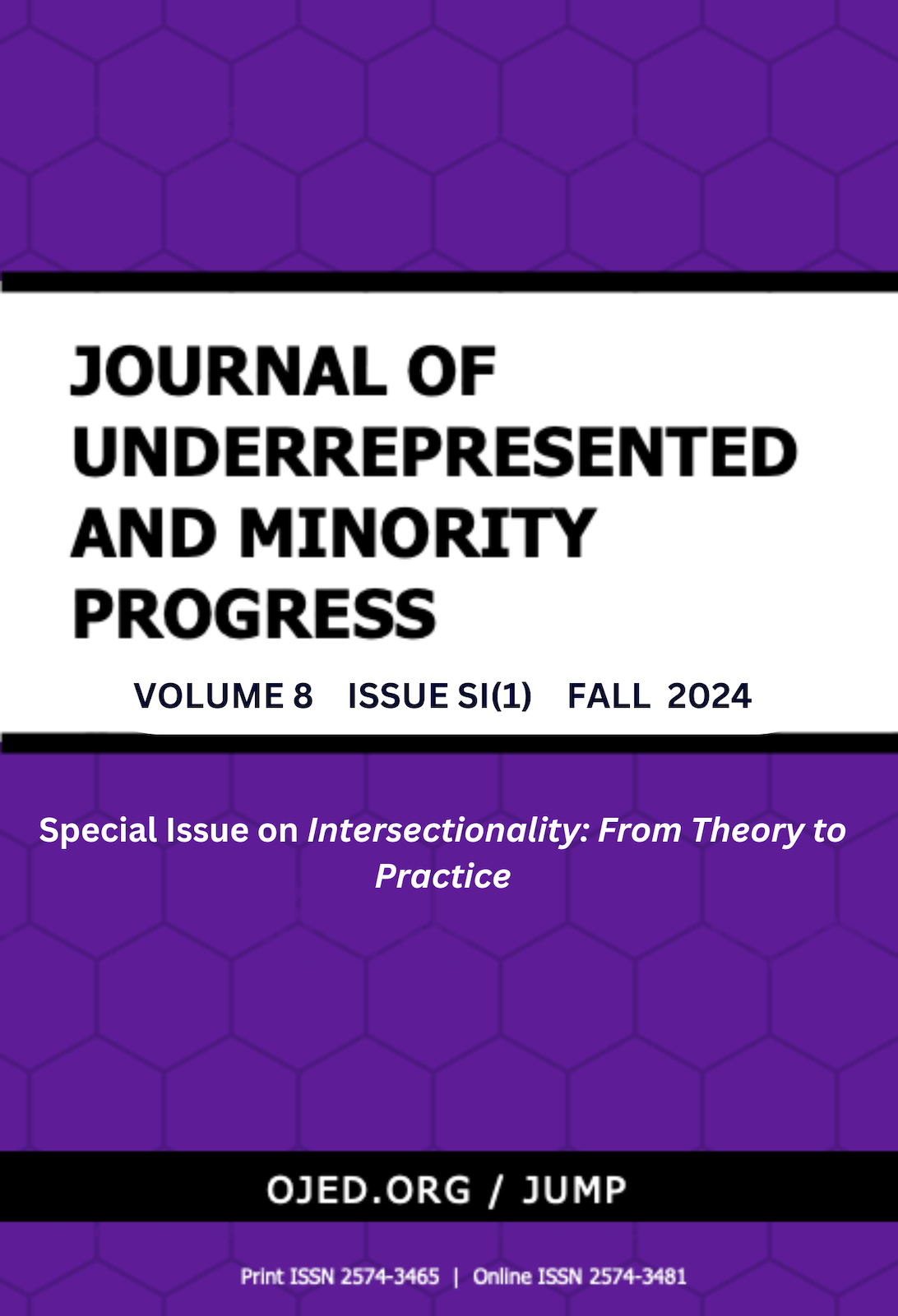When I Cry, You Cry--We Cry Together: The Intersectional Nature of Subalternity in Higher Education
DOI:
https://doi.org/10.32674/qm8q6b47Keywords:
Higher education, Intersectionality, Subalternity, Diversity, MarginalizationAbstract
In 2022, Parker et al. published a special issue in Research Issues in Contemporary Education with the intention of curating manuscripts addressing marginalization in higher education. Within the framework of Subalternity/Subaltern Studies, the current study employs a Postcolonial Critical Discourse Analysis methodology to investigate the intersectional nature of the 11 included manuscripts, thereby advancing the special issue. Findings highlight recurring themes including individual experiences, the need for theory to inform practice, and a focus on classroom dynamics. Additionally, within each manuscript numerous key terms are referred to relating to diversity, racism, and Historically Black Colleges and Universities. Last, from the findings, Black Women are prominently identified as subaltern within higher education and victims of the power dynamics at play.
References
Barnett, B. & Felten, P. (2016). Working at the intersections. Intersectionality in Action: A Guide for Faculty and Campus Leaders for Creating Inclusive Classrooms and Institutions. Stylus.
Beckers, G. G., & Calderon, P. S. (2022). A need for cultural experiences for Black students with intellectual disabilities at historically Black colleges and universities, Research Issues in Contemporary Education, 7(2), 44-53.
Brissett, N.O.M. (2020). Teaching like a subaltern: Post coloniality, positionality, and pedagogy in international development and education. Comparative and International Education Society, 64(4), 577-597.
Broussard, L. & Mallery, T. (2022).A movement, not a moment: A college level approach to the development of an inclusive learning environment, Research Issues in Contemporary Education, 7(2), 103-111.
Cosey, F. (2022). Deferring resistance when teaching Queer theory at historically Black colleges and universities, Research Issues in Contemporary Education, 7(2), 90-102
Crenshaw, K. (1991). Mapping the margins: Intersectionality, identity politics, and violence against women of color. Stanford Law Review, 43(6), 1241–1299. https://doi.org/10.2307/1229039
Dubin, R., & Beisse, F. (1967). The assistant: Academic subaltern. Administrative Science Quarterly, 11(4), 521-547.
Gadsden, C. (2022). Culturally inclusive teaching and learning that engages the whole student, Research Issues in Contemporary Education, 7(2), 35-43.
Gilmore, P., & Smith, D. M. (2005). Seizing academic power: Indigenous subaltern voices, metaliteracy, and counternarratives in higher education. In Language, Literacy, and Power in Schooling (pp. 67-88). Lawrence Erlbaum Associates. https://doi.org/10.4324/9781410613547
Grosfoguel, R. (2013). The structure of knowledge in western universities: Epistemic racism/sexism and the four genocides/epistemicides of the long 16th century. Human Architecture: Journal of the Sociology of Self-Knowledge, 10(1), 73-90.
Hatcher, J. W., Williams, T., Parker, J. L., DeVaney, T. A., Gordon, C. (2022). Perceptions of critical race theory as a tool for understanding the African American male experience, Research Issues in Contemporary Education, 7(2), 128-146.
Johnson, E., & Culverson, D. (2022).Voices on the margins: Libraries, community agency, and Black public spheres, Research Issues in Contemporary Education, 7(2), 147-170.
Kim, J. (2012). The birth of academic subalterns: How do foreign students embody the global hegemony of American universities? Journal of Studies in International Education, 16(5), 455-476. DOI: 10.1177/1028315311407510
Matius, C. E., Thompson, F. A., & Luney, L.T. (2022). When white dwarfs burn our color: Whiteness, emotionality, and the will to thrive in higher education, Research Issues in Contemporary Education, 7(2), 8-34.
McGowan, H.E. & Shipley, C. (2020). The adaptation advantage. Wiley.
Mishra, A. K. (2012). Fetishizing marginality: Contemporary Indian academia and the rise of subaltern. Labyrinth: An International Refereed Journal of Postmodern Studies, 3(3), 142-150.
Mullet, D. R. (2018). A general critical discourse analysis framework for educational research. Journal of Advanced Academics, 29(2), 116-142.
Orelus, P. W. (2018). Can subaltern professors speak? Examining micro-aggressions and lack of inclusion in the academy. Qualitative Research Journal, 18(2), 169-179. DOI 10.1108/QRJ-D-17-00057
Parker, J.L., Hornsby, E.R., Smith Y. C., & Drake, T. (2021). Letting the marginalized reestablish the margins: The multicultural dimension of academia (Call for papers). http://www.leraweb.net/ojs/index.php/RICE
Parker, J.L. Hornsby, E.R. Smith, Y. C., & Drake, T. (2022a). Letting the marginalized reestablish the margins: Multicultural dimensions of academia. Research Issues in Contemporary Education, 7(2), 1-70. http://www.leraweb.net/ojs/index.php/RICE/issue/view/16/showToc
Parker, J.L., Hornsby, E.R., Smith, Y. C., & Drake, T. (2022b). The margin as a space for reflection, thought, and possibility, Research Issues in Contemporary Education, 7(2), 1-7.
Reed, E., Figueroa, E., & Carpenter, M. (2022).What critical race theory is, what it isn’t, and why it is important, you should know: A call to action, Research Issues in Contemporary Education, 7(2), 112-127.
Sant, E. (2017). Can the subaltern nation speak by herself in the history curriculum? Educational Studies, 53(2), 105-121. DOI: 10.1080/00131946.2016.1238376
Sanz Sabido, R. (2019). Postcolonial Critical Discourse Analysis: Theory and Method. In: The Israeli-Palestinian Conflict in the British Press. Palgrave Macmillan, https://doi.org/10.1057/978-1-137-52646-5_2
Shelby-Caffrey, C. V. (2022).Uncomfortable conversations with a Black woman: Centering examinations of race, power, privilege in teacher education programs in the wake of 45, Research Issues in Contemporary Education, 7(2), 72-89
Spivak, G. C. (1994). Can the subaltern speak? In P. Williams & L. Chrisman, Colonial discourse and post-colonial theory. Columbian University Press. pp. 66-111.
Subaltern. In Ashcroft, B. Griffiths, G. & Tiffin, H. (2000). Post-colonial studies: The key concepts. Taylor & Francis.
Tinto, V. (2015). Through the eyes of students. Journal of College Student Retention: Research, Theory, & Practice. 19(3), 254-269.
Thompson, V. J. (2022).Politics, identity, faith, and the academic hazing of a Black woman: A scholarly personal narrative of a black woman doctoral student. Research Issues in Contemporary Education, 7(2), 54-71.
Trowler, V. (2014) May the subaltern speak? Researching the invisible ‘other’ in higher education, European Journal of Higher Education, 4:1, 42-54, DOI:10.1080/21568235.2013.851614
Wagner, J. L. (2013). The student as subaltern: Reconsidering the role of student life material collections at North American universities. Archival Issues, 35(1), 37-51.
Winkler, K & Scholz, S. (2021). Subaltern thinking in religious education? Postcolonial readings of (German) schoolbooks. British Journal of Religious Education, 43(1), 103-122. https://doi.org/10.1080/01416200.2020.1810633
Wright-Maley, C. (2022). Time, temporality, and entanglement in the face of parallel realities. Journal of Folklore and Education, 9, 8-24.


